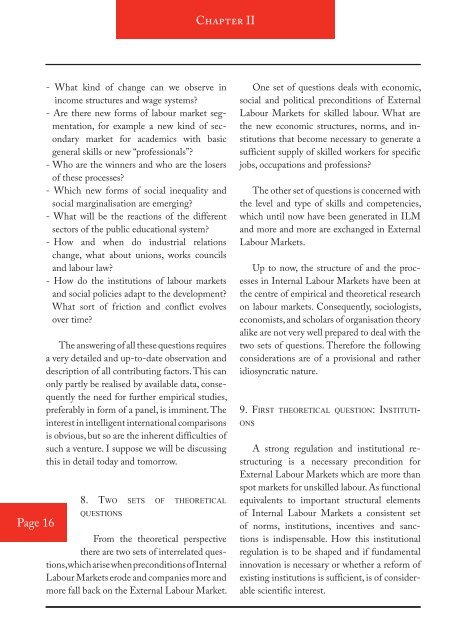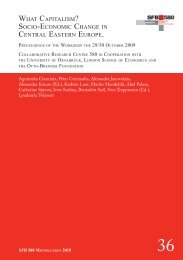trends in employment stability and labour market segmentation
trends in employment stability and labour market segmentation
trends in employment stability and labour market segmentation
Create successful ePaper yourself
Turn your PDF publications into a flip-book with our unique Google optimized e-Paper software.
CHAPTER II I<br />
- What k<strong>in</strong>d of change can we observe <strong>in</strong><br />
<strong>in</strong>come structures <strong>and</strong> wage systems?<br />
- Are there new forms of <strong>labour</strong> <strong>market</strong> <strong>segmentation</strong>,<br />
for example a new k<strong>in</strong>d of secondary<br />
<strong>market</strong> for academics with basic<br />
general skills or new “professionals”?<br />
- Who are the w<strong>in</strong>ners <strong>and</strong> who are the losers<br />
of these processes?<br />
- Which new forms of social <strong>in</strong>equality <strong>and</strong><br />
social marg<strong>in</strong>alisation are emerg<strong>in</strong>g?<br />
- What will be the reactions of the different<br />
sectors of the public educational system?<br />
- How <strong>and</strong> when do <strong>in</strong>dustrial relations<br />
change, what about unions, works councils<br />
<strong>and</strong> <strong>labour</strong> law?<br />
- How do the <strong>in</strong>stitutions of <strong>labour</strong> <strong>market</strong>s<br />
<strong>and</strong> social policies adapt to the development?<br />
What sort of friction <strong>and</strong> conflict evolves<br />
over time?<br />
The answer<strong>in</strong>g of all these questions requires<br />
a very detailed <strong>and</strong> up-to-date observation <strong>and</strong><br />
description of all contribut<strong>in</strong>g factors. This can<br />
only partly be realised by available data, consequently<br />
the need for further empirical studies,<br />
preferably <strong>in</strong> form of a panel, is imm<strong>in</strong>ent. The<br />
<strong>in</strong>terest <strong>in</strong> <strong>in</strong>telligent <strong>in</strong>ternational comparisons<br />
is obvious, but so are the <strong>in</strong>herent difficulties of<br />
such a venture. I suppose we will be discuss<strong>in</strong>g<br />
this <strong>in</strong> detail today <strong>and</strong> tomorrow.<br />
8. TWO SETS OF THEORETICAL<br />
QUESTIONS<br />
Page 16<br />
From the theoretical perspective<br />
there are two sets of <strong>in</strong>terrelated questions,<br />
which arise when preconditions of Internal<br />
Labour Markets erode <strong>and</strong> companies more <strong>and</strong><br />
more fall back on the External Labour Market.<br />
One set of questions deals with economic,<br />
social <strong>and</strong> political preconditions of External<br />
Labour Markets for skilled <strong>labour</strong>. What are<br />
the new economic structures, norms, <strong>and</strong> <strong>in</strong>stitutions<br />
that become necessary to generate a<br />
sufficient supply of skilled workers for specific<br />
jobs, occupations <strong>and</strong> professions?<br />
The other set of questions is concerned with<br />
the level <strong>and</strong> type of skills <strong>and</strong> competencies,<br />
which until now have been generated <strong>in</strong> ILM<br />
<strong>and</strong> more <strong>and</strong> more are exchanged <strong>in</strong> External<br />
Labour Markets.<br />
Up to now, the structure of <strong>and</strong> the processes<br />
<strong>in</strong> Internal Labour Markets have been at<br />
the centre of empirical <strong>and</strong> theoretical research<br />
on <strong>labour</strong> <strong>market</strong>s. Consequently, sociologists,<br />
economists, <strong>and</strong> scholars of organisation theory<br />
alike are not very well prepared to deal with the<br />
two sets of questions. Therefore the follow<strong>in</strong>g<br />
considerations are of a provisional <strong>and</strong> rather<br />
idiosyncratic nature.<br />
9. FIRST THEORETICAL QUESTION: INSTITUTI-<br />
ONS<br />
A strong regulation <strong>and</strong> <strong>in</strong>stitutional restructur<strong>in</strong>g<br />
is a necessary precondition for<br />
External Labour Markets which are more than<br />
spot <strong>market</strong>s for unskilled <strong>labour</strong>. As functional<br />
equivalents to important structural elements<br />
of Internal Labour Markets a consistent set<br />
of norms, <strong>in</strong>stitutions, <strong>in</strong>centives <strong>and</strong> sanctions<br />
is <strong>in</strong>dispensable. How this <strong>in</strong>stitutional<br />
regulation is to be shaped <strong>and</strong> if fundamental<br />
<strong>in</strong>novation is necessary or whether a reform of<br />
exist<strong>in</strong>g <strong>in</strong>stitutions is sufficient, is of considerable<br />
scientific <strong>in</strong>terest.

















